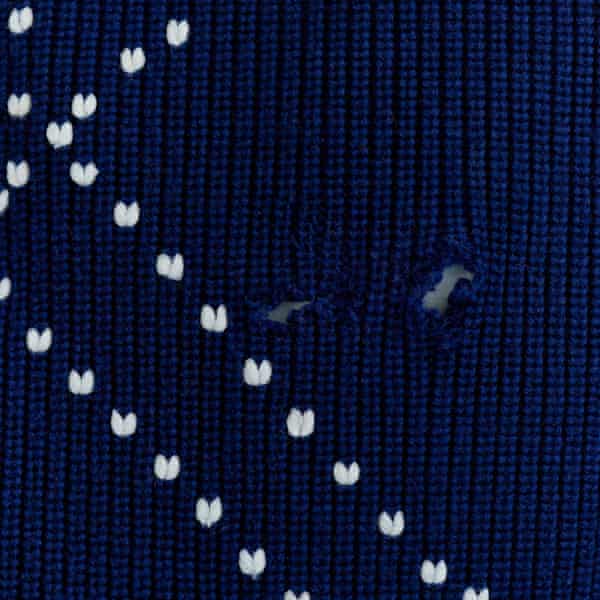
Images and Article from www.theguardian.com.
We all know the feeling. You dig out one of your favourite jumpers only to find that the moths have had a field day and filled it with holes. Don’t panic. In the first of a new series on repairing and upcycling treasured items instead of throwing them away, we try out a woollens mending service to solve the problem.
The Raf Simons jumper above belongs to one of our colleagues who carefully stores her knitwear at the end of the winter in vaccum-packed bags in her loft. But when she pulled this one out she discovered, despite her best efforts at prevention, that it had been ravaged by moths – four 10p-size holes across the front. After following advice from English Heritage to freeze the jumper for two weeks to kill the moth larvae we took the holy knit to our knitwear shoot where one of the Seam’s makers, Georgia de Castro Keeling breathed new life into the sweater.
London-based entrepreneur Layla Sargent has created the Seam to help solve exactly this type of problem. Helping people to love their clothes, the Seam’s growing network of 700 ‘makers’ – comprising Savile Row tailors, theatre costumiers, fashion students and professional seamstresses among others – currently services thousands of customers, mending clothes, not only jumpers, that might have seen better days, as well as altering clothing for the perfect fit so as to increase the lifespan of a garment.
After being thoroughly vetted, the maker goes to the customer’s home or in some cases the maker’s studio, to fix your prized possessions. Prices range from £3 to replace a button to £70 to replace the lining of a dress, with the majority of jobs – such as adjusting waistbands on trousers, re-hemming a dress, or mending a tear or hole – costing £15. Made-to-measure and bespoke projects have custom pricing agreed between the maker and the customer.
Like most great business ideas, the Seam is the result of a lightbulb moment stemming from personal experience. Growing up in Birmingham, 32-year-old Sargent had her seamstress grandmother, Patricia Baxter, tailor her clothes to fit her 6ft frame and says she thought it was something that everyone had access to growing up – until she realised they didn’t. “Naively, I thought that was normal! But I started to realise that my friends had a very different relationship with fashion – they would wear stuff and throw it away very quickly,” Sargent tells the Observer.
Such dissatisfaction combined with the rise of throwaway culture propelled the idea from brainwave to full-blown business model. “As I learned more about the ever-increasing climate crisis, I thought, ‘Why can’t we do this better? Why can’t more people have access to people who will help them love their clothes for longer?’”
Statistics confirm the need for social enterprises like Sargent’s, who points to a 2017 report from WRAP that suggested clothing-repair models offer the potential to extend the average life of a garment from 3.3 years to 4.5 years, which if applied to just 5% of clothing in the UK would save an estimated 80,000 tonnes of CO2 and £5bn in resources used to supply, launder and dispose of clothing.
She also has her own research to share. “We interviewed 200 women in London and found that 81% think their body shape is abnormal,” says Sargent. “That isn’t by mistake. We’ve grown up trying to squeeze and squash our bodies into clothes made with standardised sizing that are essentially made for everybody and nobody. What we’ve been left with is this really unhealthy mentality that the problem is with our bodies and not with our clothes.”
Next year will see the Seam expand into yet-to-be-announced new areas of the UK, but before then it is partnering with rental fashion service By Rotation to help its users repair and restore clothes to keep them rentable for longer. It’s a part of the Seam’s ongoing mission to “close the loop on circularity” says Sargent.
For more details and how to use the service, go to theseam.uk
Article shared from www.theguardian.com



